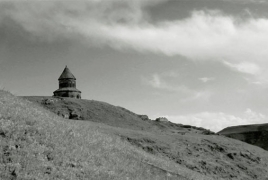
CNN published an article describing the works of contemporary artists Francis Alys and Michael Rakowitz showcased at Istanbul Biennial, one of the major themes of which is the Armenian Genocide. The article also describes the artists’ personal responses to the crime against humanity.
The article reads:
‘The Silence of Ani’ begins with the rustling of wind through a breathtaking city that now lies in ruins. The artist behind the film, Francis Alys, says he worries it is ‘too poetic’. If he had time to do it again, he might make something more critical: his starting point, after all, was a genocide in which more than a million Armenians were massacred.
The notes accompanying the film, currently on display at this year's Istanbul Biennial, tells us that these ruins were once Ani, one of the most technologically impressive cities of the medieval world.
Ani, silent since the 17th century, speaks of a more modern absence: of the Armenian populations across Turkey who were killed and deported by Ottoman forces in 1915, and of a catastrophe whose name it is forbidden to teach in Turkish classrooms.
Turkey's president, Recep Tayyip Erdogan has steadfastly refused to recognize the massacres as a deliberately orchestrated genocide. Yet works at the exhibition by contemporary artists have formed a rising chorus of opposition in the heart of the country's largest city.
The biennial's curator Carolyn Christov-Bakargiev has made recognition of the Genocide and Armenians' cultural legacy a major theme of the event.
Alys and Michael Rakowitz, an American conceptual artist of Iraqi-Jewish descent explain why and how they took on this monumental issue.
Michael Rakowitz' installation The Flesh Is Yours, The Bones Are Ours takes place on the third floor of a primary school for Greek children which closed in the 2007. Other events take place in the former offices of Armenian newspaper Agos, an Italian school and workers club, and a French Orphanage.
Here, across a whole floor of the school, he lays out a complex narrative, born out of his own extensive research. It weaves together the city's architectural history: a mixture of European baroque and art nouveau, Islamic and Levantine styles that mingle in the interior of the city's historic buildings.
Visitors can take in the collected objects -- plaster casts, newspaper clippings, photos, letters, bones of slaughtered dogs, the remains of Armenian farms -- in any order they wish.
They learn the story of Kemal Cimbiz, the real-life Turkish apprentice of an Armenian master craftsman, Garabet Cezayirliyan, who made plaster decorative motifs that still line ceilings across Istanbul.
Rakowitz says 1915 interested him because "it's one of those moments that nation building gives way to a certain kind of amnesia". As the Ottomans attempted to build a Turkish nation, the Armenian minority -- among other groups -- were stripped of land, property, and aspects of their distinct cultural history, he says.
"I was interested in the fact that Armenians have contributed so much to the creation of the city of Istanbul."
Belgian-born, Mexico-based Francis Alys says he had "a little bit" of knowledge about the massacres before he began working on this project, which he'd picked up from fellow artists who belong to the Armenian Diaspora.
But the nine months between being invited to contribute by Christov-Bakargiev and the launch of the Biennial unfolded quickly, with 56-year-old Alys editing his film until late on the night before opening.
"I had to kind of squeeze it" he says. "And it's maybe the reason why the end result is a 'fable'."
Alys spent a week with the children who appear on the stark black-and-white film, discussing the performance and their understanding of the events of 1915. But among this group, living in a once-Armenian region, there is a startling lack of knowledge of the Genocide, Alys claims.
"We're talking about a case of rewriting history that has been extremely efficient," Alys says.

